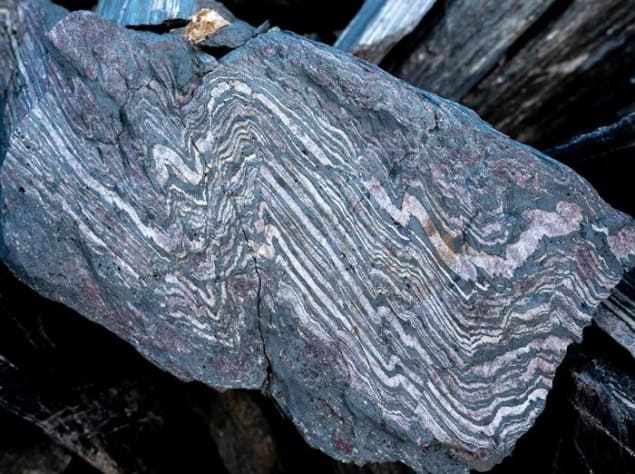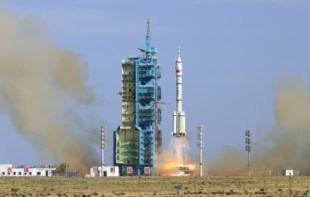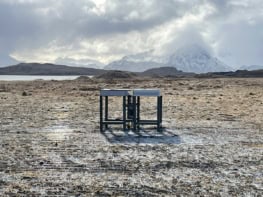
Ancient organisms preserved in the Earth’s oldest fossils may have experienced a planetary magnetic field similar to the one we observe today. This finding, from a team of researchers at the University of Oxford, UK and the Massachusetts Institute of Technology in the US, suggests that the planet’s magnetic field was relatively strong 3.7 billion years ago – a fact with important consequences for early microbial Earthlings.
“Our finding is interesting because the Sun was generating a much more intense solar wind in the Earth’s early history,” explains team leader Claire Nichols of Oxford’s Department of Earth Sciences. “This means that the same strength of magnetic field would have provided far less shielding (because the protective ‘bubble’ around Earth provided by the magnetosphere would have been much smaller) for life emerging at that time.”
Without the magnetosphere, which protects us from cosmic radiation as well as the solar wind, many scientists think that life as we know it would not have been possible. Until now, however, researchers weren’t sure when it first appeared or how strong it was.
Unique rock samples
In the new work, Nichols and colleagues analysed rocks from the northern edge of the Isua Supracrustal Belt in southwest Greenland. Billions of years ago, as these rocks were heated, crystals of magnetite formed, and iron oxide particles within them recorded the strength and direction of the ambient magnetic field.
While similar processes happened in many places and at many times during Earth’s history, the rocks in the northernmost part of Isua are extremely unusual. This is because their location atop a thick continental crust prevented their magnetic information from being “erased” by later geological activity.
Indeed, according to the researchers, this band of land experienced only three significant thermal events in its history. The first and hottest occurred 3.7 billion years ago and heated the rocks up to 550 °C. The two subsequent heating events were less intense, and because they did not heat the rocks to more than 400 °C, the 3.7-billion-year-old record of Earth’s magnetic field remains as it was after the first event locked it in.
Recovering a vector of magnetization
Collecting samples from Isua was challenging, Nichols says, because the sample site is so remote it can only be reached by helicopter. Once back in the laboratory, the team demagnetized the samples stepwise, either by gradually heating them or by applying increasingly strong alternating magnetic fields. “These processes allow us to slowly remove the magnetic signal from the samples,” Nichols explains, “and recover a vector of magnetization that tells us about the direction of the ancient magnetic field.”
To determine the strength of the ancient field, the researchers applied a known magnetic field and compared the vector of magnetization acquired in the lab to that recovered in the original demagnetization. They found that rocks dating from 3.7 billion years ago recorded a magnetic field strength of at least 15 microtesla (µT). To compare, Earth’s present-day magnetic field averages around 30 µT. These results constitute the oldest estimate of the Earth’s magnetic field strength ever recovered from bulk rock samples – a method that is more accurate and reliable than previous analyses of individual crystals.
Consequences for early life
The fact that the Earth’s magnetic field was already fairly strong 3.7 billion years ago has several implications. One is that, over time, as the solar wind decreased, life on Earth would have become progressively less likely to experience high levels of ionizing radiation. This may have allowed organisms to move onto land and leave the more protective environment of the deep oceans, Nichols says.

Ancient lull in Earth’s magnetic field may have allowed large animals to evolve
The results also suggest that Earth’s early magnetic dynamo was as efficient as the mechanism that generates our planet’s magnetic field today. This finding will help scientists better understand when the Earth’s inner, solid core began to form, potentially shedding light on processes such as mantle convection and plate tectonics.
Are magnetic fields a key criteria for habitability?
Perhaps the most profound implication, though, concerns the possibility of life on other planets. “Understanding the oldest record of Earth’s magnetic field is really important for figuring out whether magnetic fields are a key criteria for habitability,” Nichols tells Physics World. “I’m really interested to know why Earth appears so unique – and whether the magnetic field matters for its uniqueness.”
The technique developed in this study, which is detailed in the Journal of Geophysical Research, could be used to study other very old rocks, such as such as those found in Australia, Canada and South Africa. Nichols says her next big project will be to carry out similar studies on these rocks.



